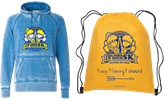Greater Good

Whether a for-profit group looks for opportunities to serve outside the workplace, or a nonprofit exists solely to serve a particular group, promotional products can be an integral part of enhancing service initiatives. Key to successfully pairing promotions with nonprofit programs is understanding the mission of the organization, its needs and the needs of the end user.
Giving is on the rise, according to Giving USA 2018: The Annual Report on Philanthropy for the Year 2017. Researched and written by Indiana University Lilly Family School of Philanthropy, the report is sponsored by Giving USA Foundation, a public service initiative of The Giving Institute.
Total contributions to nonprofits in 2017 were $410.02 billion, a three percent increase over 2016. Many of these gifts are being contributed to foundations and donor-advised funds, the report shows, which means a longer period of time will pass before nonprofits will be able to put those funds to work.
Corporate giving also has increased, growing by eight percent to $20.77 billion in 2016, though donations as a percentage of corporate pre-tax profits have shrunk over the past 20 years.
In the promotional products industry, more companies are working hand in hand with local nonprofits as well as creating their own charitable foundations. ePromos for Good, the charitable arm of distributor ePromos, gives away free promotional products throughout the year to 501(c)(3) organizations, accredited schools and religious organizations who demonstrate a need.
At supplier Hanesbrands, The Hanes® and Champion® Hanes4Education™ Program helps raise funds for public and private K-12 schools through the sale of Hanes® and Champion® printed apparel purchased from screen printers and distributors for use as corporate apparel, team uniforms and event shirts.
---
Market Snapshot
Nonprofit groups in the United States are organized under 29 different tax-exempt classifications, and the Bureau of Labor Statistics found that the most common is 501(c)(3)—two out of every three nonprofits fall into this category.
501(c)3 organizations focus on a number of causes, such as:
- Animal welfare
- Child welfare
- Public safety
- Religious
- Scientific pursuits
- Charitable
- Educational
- Literary
Nonprofit employment, total annual wages, and the number of establishments grew steadily each year from 2007 through 2012, even during the 2007–09 recession, according to the Bureau of Labor Statistics. Average employment numbers among nonprofits in 2012 was 11,426,870, with total annual wages of $532 billion.
Nonprofits across the country employed the largest percentages of individuals in Pennsylvania (15.9 percent), New York (18.1 percent), Vermont (19.9 percent), Maine (17.7 percent), Massachusetts (17.7 percent) and Rhode Island (18.1 percent). Conversely, Nevada-based nonprofits employed just 2.7 percent of the working population.
Nonprofit employment within industry sectors varied widely, with 70 percent employment in the educational services sector, 46 percent in health care and social assistance, and 17 percent in “other” services.
The majority of nonprofits—90 percent—operated in three specific industries: health care and social assistance (68 percent); educational services (16 percent) and “other” services.
Among the categories examined by the Giving USA 2018 study, religious organizations were the top recipient of charitable giving, receiving $127 billion in contributions—a 2.9 percent increase over the previous year. Environmental and animal organizations, in contrast, received just $11.83 billion—although the amount was an increase of 7.2 percent over 2016.
---
Getting In On The Ground Floor
Organizations
National Council Of Nonprofits
www.councilofnonprofits.org
Society For Nonprofits
www.snpo.org
National Association of Nonprofit Organizations & Executives
nanoe.org
Nonprofit Hub
nonprofithub.org
Issues
- Limited resources
- Rising demands based on increasing community needs
- The need for advocacy by nonprofit leaders at local, state and national levels
- Corporate causes competing with local nonprofits for donor-directed funds
- Finding new ways to engage with volunteers
Trends
- Engaging donors through technology
- Transitional groups that serve temporary needs
- The use of big data
- Collaboration through social media
- Millennials in nonprofit leadership
---
Give Thanks With Great Gifts
A little appreciation goes a long way, and Associations Now recently rounded up a few memorable ways to show donors, volunteers and supporters how valuable they are to the organizations they support.
1. The Welcome Kit
Whether it comes in a box or a tote, a carefully curated custom kit filled with thoughtful goodies is considered the epitome of “surprise and delight.”
2. Practical Products
It doesn’t matter if it’s pretty—if the recipient can’t use it, they won’t keep it. Pick products that have a long life ahead of them and can be uniquely customized.
3. Weighted Wearables
Whether it’s a full piece of clothing—such as a collectable, limited edition t-shirt—or commemorative patches for workwear, wearables are tried- and-true gifts available in plenty of high-end options.
4. Prize Partnerships
Elevate co-op advertising by going in together on premium incentives and gifts that can be co-branded, so recipients know exactly whom to thank.
---
Real-World Solutions
Year-Round Inspiration
![]()
A nonprofit organization was looking for an item that would do two things: thank volunteers and provide exposure for the group. The nonprofit mailed the stapled Inspiration appointment calendar along with a thank-you letter to all of its volunteers. The 13-month, four-color wall calendar featured a different nature scene paired with an uplifting quote each month.
The nonprofit felt that many of the volunteers would keep the calendar in their kitchen, which is a primary gathering space in many homes. As a result, the group saw an increase in the number of volunteers, and it plans to provide the calendars each year.
Source: Beacon Promotions
Thumbs Up 5K for Mental Health Awareness

When Katie Shatusky made the leap from employee to nonprofit founder, ASB account manager Jake Forslund was there to help her at every turn. Shatusky had been Forslund’s contact at her previous company, and the two built on their professional relationship to make sure Shatusky’s Thumbs Up 5K Run for Mental Health Awareness had a successful start.
Forslund has donated design time and printed pieces in the years since Thumbs Up was launched, and he has helped provide creative solutions in promotional products and marketing strategy for Shatusky and her co-founder, Jessica Hackenmueller. Items include apparel, banners, signs, wristbands, pins and other products to help spread the message. In 2017, he joined the committee and helped organize and work the 5K event.
“I am really proud of what the Thumbs Up organization has accomplished,” says Forslund. “The smile pins really can make someone’s day, but this group keeps working hard to make someone’s week, month, year, decade … most importantly, it’s a chance to catch those at a difficult crossroads in life. It’s these moments where someone needs every glimmer of hope and light they can get. It might be a button, a cheer bag, or even a scholarship for the mental health field, but the conversations they create can mean the world to someone.”
Source: American Solutions For Business
---
For additional related products, please view this story in the flipbook.
Jen Alexander is associate editor of PPB.

